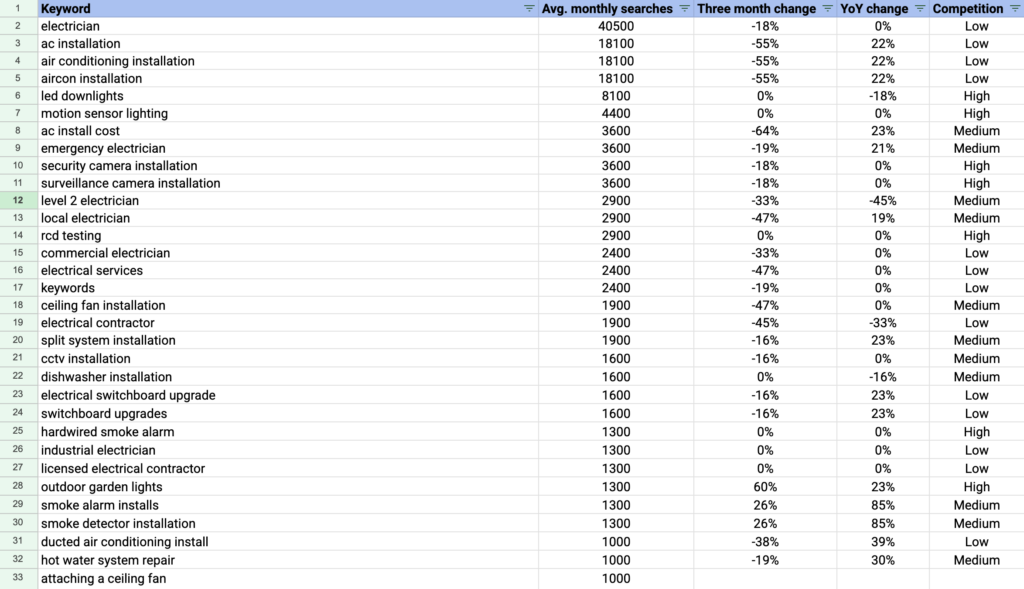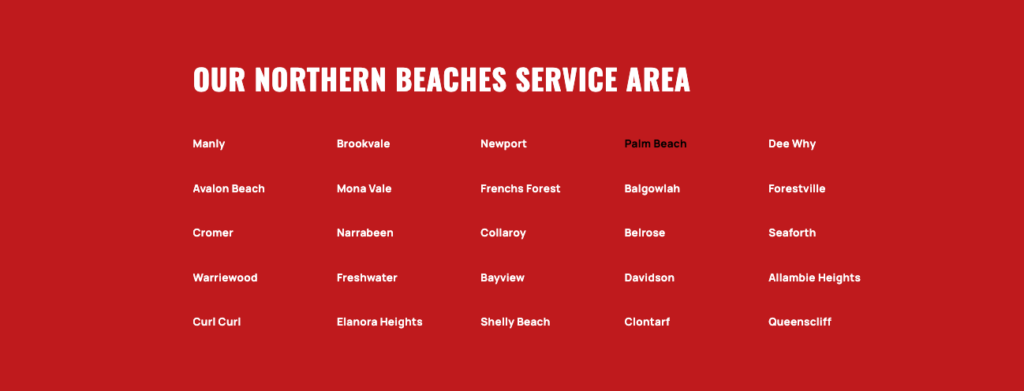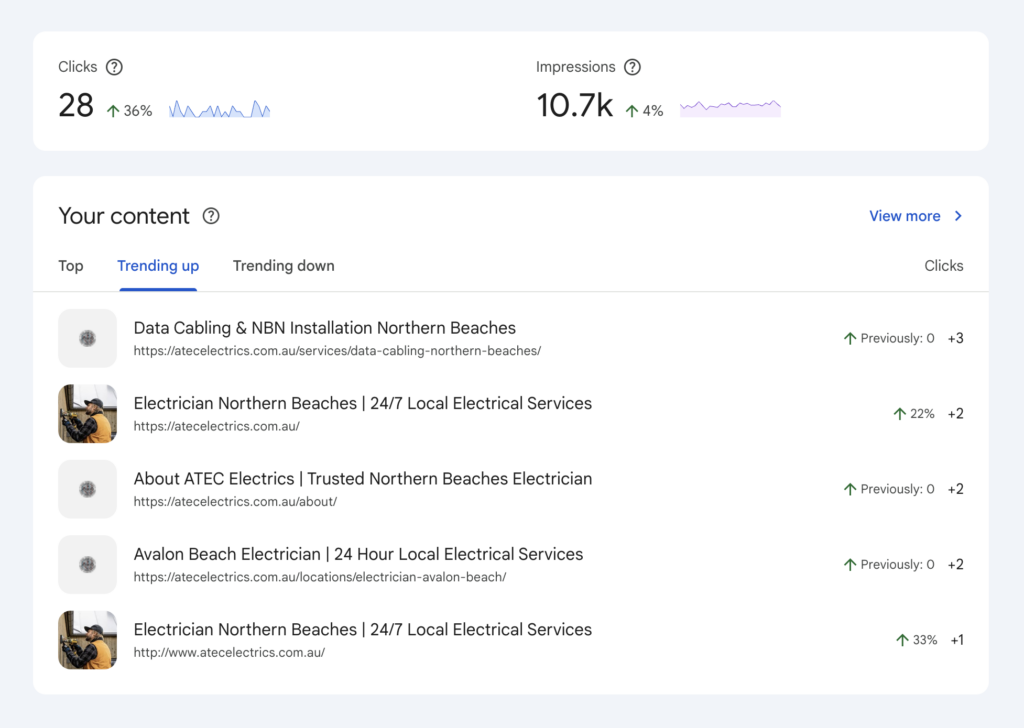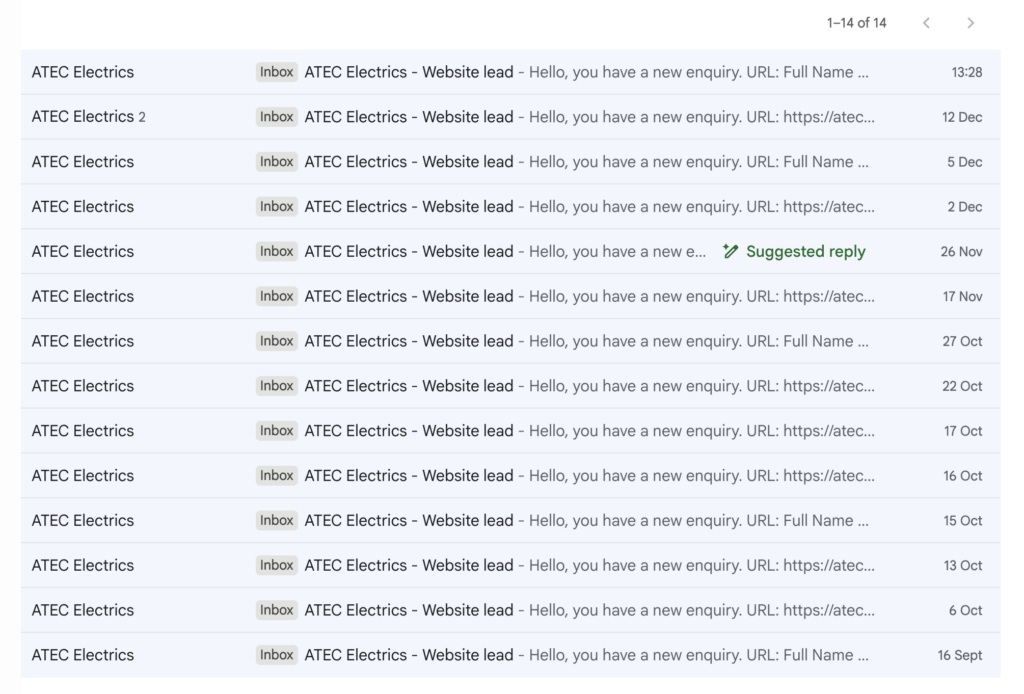ATEC Electrics is a local electrician based on Sydney’s Northern Beaches. Like many small trade businesses, they had technical skills and a loyal customer base, but they weren’t yet highly visible online in the suburbs they wanted to service.
This case study shows how we created a new website for ATEC Electrics, then structured the agreement to include marketing services to drive traffic and generate new enquiries. To keep outcomes accountable, the marketing fees were performance-based, with fees only paid once agreed lead targets were achieved.
Understanding the business and opportunity
Getting clear on who ATEC Electrics is
ATEC Electrics prioritises work in the Northern Beaches area. This focus works in their favour because search engines now place a lot of emphasis on intent and proximity based relevance. For tradies, local search engine optimisation (SEO) is one of the most reliable and cost-effective ways to generate leads because it can connect you with nearby people who are actively searching for the service.
In our discovery conversations with the client, we asked questions to shape the website structure, ensuring the right suburbs and services were reflected throughout the content.
- Which suburbs are most important to grow in the next 12 to 24 months?
- Which services are most profitable or most in demand – e.g. emergency callouts, LED upgrades, switchboard work, air conditioning, shop fit outs and so on?
- What kind of jobs do they want more of, and which ones are lower priority?
Designing for conversion
A big part of conversion is the look and feel, so we focused on creating a design that reflected the strength of the brand and service. We knew that generating traffic was only half the job. The website also needed to convert traffic into enquiries.
We explored design references that leaned into a strong red and black colour palette, using clear hierarchy, high contrast sections and prominent calls to action so visitors could quickly understand the offer and take the next step.

Our target objectives
It was imperative that the website proved ROI, with clear outcomes that could be used to measure success. Our goal was to reach 100 leads within 18 months, and to achieve this the website had to:
- Show Google that ATEC Electrics is intrinsically tied to the Northern Beaches vicinity
- Match user search behaviour for local services and suburbs with ATEC’s website
- Convert website visitors into enquiries
That mindset influenced every decision we made – from keyword research and information architecture all the way through to how we designed the website.
Building a local SEO framework around services and locations
Mapping the search opportunity
Once we understood the business priorities, we used Ahrefs to map out the search opportunity. We looked at data around:
- Core service keywords that people search for – for example “emergency electrician”, “LED downlight installation”, “switchboard upgrade”
- Local intent phrases combining services and suburbs – for example “electrician manly”, “local electrician newport”
- Search volume and difficulty to identify which terms offered the best chance of ranking and generating enquiries in the short to medium term

Table: List of electrician-related keywords associated with different areas of the Northern Beaches
Creating dedicated service pages
We then created a structured services hub for ATEC Electrics and built out individual service pages underneath it. In total there were around a dozen focused pages, each tailored to a specific service such as:
- AC and aircon installation
- LED lighting installations and retrofits
- Switchboard upgrades and safety switches
- Ceiling fan and exhaust fan installations
- Emergency and after hours callouts
- Appliance and hot water connections

Table: List of keywords associated with electrician services ranked by average monthly search volume
Creating location pages for the Northern Beaches
In parallel, we created a locations hub that highlights priority suburbs across the Northern Beaches. These pages are designed to show both users and search engines that ATEC Electrics is locally based.

Cross-linking services and locations for stronger relevance
Another key step for improved rankings in Google and Bing was making sure our service pages and location pages supported each other. Wherever it made sense, we:
- Linked from a service page to one or more locations – for example, emergency electrician content referencing service areas across the Northern Beaches
- Linked from a location page back to specific services that are popular in that suburb
- Wove suburb names naturally into headings, paragraphs and calls to action without keyword stuffing
This cross-linking means that search engines can clearly see “ATEC Electrics + [service] + [suburb]” as a strong, relevant combination – and it also helps users move quickly from “I am in this suburb” to “this is the exact service I need”.
Turning every page into a conversion-focused landing page
Treating service and location pages as entry points
These days, the way people search, and the way search engines distribute traffic, means users rarely enter through the homepage. For tradies, they are more likely to land on a specific service or suburb page that matches their query, which makes long tail keywords essential. Because of this, we designed each key page to act as its own landing page.
That meant every page needed to:
- Explain who ATEC Electrics is and build credibility
- Describe the service or suburb clearly
- Answer common objections – price, response time, safety, quality
- Offer multiple clear calls to action

Built-in redundancy in calls to action on every page.
To capture different preferences, we placed several call to action options on each page, including:
- Phone calls – click-to-call buttons for users who want to talk to someone immediately
- Website enquiry forms – multiple forms to request a quote or ask a question
This approach ensures that whether someone is on mobile at work, on a laptop at home or just browsing quietly at night, there is always a low-friction way to get in touch.
Tracking enquiry submissions and understanding what works
In the trades industry, leads often come through phone calls because people want to connect immediately for certain services, such as emergency electrical work. One of the challenges with this is that phone calls can be harder to track with 100% accuracy. Tools like CallRail can help, but phone leads are harder to measure and learn from unless you have call tracking and recording set up properly.

Example lead generated from local SEO and marketing
For online enquiries, our preference is to encourage form submissions, and we implemented a simple, reliable tracking approach for ATEC Electrics:
- Each form submission captures the exact URL the user converted on
- We can see which service pages, locations or combinations of the two are generating the most enquiries
- Data flows through to reporting tools so we can attribute leads properly
We also set up Google Analytics and Google Search Console so we can see which queries are driving impressions and clicks for key services and locations, how users behave once they land on the website and any technical or indexing issues that might hold back performance over time.

Screenshot from Google Search Console showing the growth in impressions and clicks on the website
Complementing the website with an improved Google Business Profile
Local visibility is more than just organic rankings
For trades like ATEC Electrics, the Google Business Profile (GBP) can be the first touchpoint a local customer sees. We have also found evidence that a stronger GBP can drive more enquiries through the website.
As part of the project we:
- Optimised the GBP with accurate category selections, service descriptions and contact details
- Ensured the profile reinforced ATEC Electrics’ Northern Beaches focus
- Aligned the GBP content with the services and suburbs highlighted on the website

Designing a post-service review process
From our experience, organic rankings on search engines are also heavily influenced by reviews. To support that, we helped ATEC Electrics implement a post-service review process that fits seamlessly into day-to-day operations.
Together with the client we discussed:
- A simple script the electrician can use at the end of a successful job
- How to introduce a review request naturally
- Sending a message with a direct link to the Google Business Profile review form
The goal is a self-perpetuating loop where, each month, a handful of customers leave reviews, which supports local rankings, leads to more enquiries and creates even more happy customers.
A performance-based model that feels fair for small businesses
Why traditional SEO retainers are often out of reach for small businesses
In many agencies, a local SEO campaign like this would sit in the $5,000 to $10,000 per month bracket. For a small trade business, that is a serious commitment, especially when they have limited visibility into the process and no guarantees around results.
The reality is that most small businesses will not invest that kind of money if they understand the benefits of SEO. The opportunity is there, but without transparency and accountability, the risk is too high to justify the spend. As a result, many delay the decision or do nothing at all because they cannot confidently predict what they will get back.
Getting paid when marketing results are delivered
For ATEC Electrics, we took a different approach. We treated the marketing work as part of the website project:
- The client paid for the design and build of the website
- SEO and local lead generation work was included, with performance-based bonuses tied to results
- If the website did not generate leads, we did not receive additional pay
This model felt fair to the client because it aligned incentives. If the website and marketing work delivered, everyone won. If they did not, the business was not locked into an expensive retainer.
We were able to offer this kind of arrangement because the website sat at the centre of the work, and it gave us a clear way to create and demonstrate value. By combining website design with marketing and the right digital strategy, we could connect the deliverables to business outcomes, then use data to demonstrate a clear return on investment.

Leads generated through the ATEC Electric website since going live with the new website redesign
As of the date of writing, we have generated 14 website enquiry submissions and a similar number of phone calls in approximately 3-months, which puts us on track to reach 100 leads in a year.
Using data to guide the next phase of growth
Identifying which services and suburbs are rising to the top
Now that the website is live and the SEO foundations are in place, the next step will be to let the website’s performance play out, then learn from the data that emerges. We are particularly interested in:
- Which service pages generate the highest volume of enquiries
- Which suburbs deliver the best quality leads or repeat work
- Queries in Google Search Console that show demand we have not fully targeted yet
If a particular service and suburb combination consistently drives enquiries that becomes a signal for further optimisation.
What this means for other small businesses
A repeatable framework, not just a one-off success
At Studio Web Design, we conceptualised this model to help small businesses make success attainable. The website is central to this idea because it is where people go to learn who you are, check your credibility, view your work and decide whether to contact you. It is also where enquiries can be tracked, improved and scaled over time.
For many tradies and other small businesses, the hardest part about investing in marketing is committing to a large spend when the outcome feels uncertain. That is why we built a model with clear reporting and performance-based marketing fees.
Any upfront investment goes into building the website properly, then marketing costs are tied to outcomes. When enquiries and sales grow, we share in that upside. If they do not, the client is not left paying fees that are not improving bottom line revenue.
How to work with Studio Web Design on your own website and marketing
The ATEC Electrics website was built in partnership with our Aus Tradie Websites brand, which specialises in website design for electricians and other trades. If you’d like support with your own business, we’d love to help. Contact our team to discuss your website design requirements.